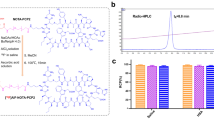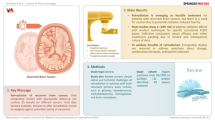Abstract
Purpose/Objective: Some malignant brain tumors shed cells into the cerebrospinal fluid (CSF). These tumors may implant throughout the neuroaxis via the CSR With the placement of a ventriculoperitoneal (VP) or ventriculoatrial (VA) shunt, tumor cells free-floating in the CSF may be carried through the shunt to the remainder of the body. Mechanical filtration devices to prevent this are not reliable. We report the development of a new device capable of reducing the incidence of shunt promoted metastasis.
Materials & Methods: The device exposes the draining CSF, as it passes through a baffle system, to a localized high-intensity radiation field adequately shielded from surrounding normal tissue. The prototype consists of geometrically fixed iodine-125 (125I) sources. The device accommodates the maximum CSF flow rate of 500 ml/24 hours. Radiation exposure to clonogenic cells occurs as they transit through the baffle system. Since the volume of the prototype device is 14 ml, a tumor cell floating through the device will be exposed to radiation for 40 minutes. Utilizing the human medulloblastoma cell line D425 MED, a limiting dilution clonogenic assay was performed. Suspensions of tumor cells in liquid medium were pumped through the device at the maximum anticipated CSF production rate of 0.35 ml/min. After the cells, with their tissue culture medium, were received from the device, a series of nine 5-fold dilutions were prepared from the suspensions which initially contained 106 tumor cell/ml. Plates were then incubated and growth was demonstrated by visual scoring of colonies of more than 20 cells. Limiting dilution data analysis was performed. Radiation surveys of the fully loaded (approximately 1.8 Ci) 125I prototype were conducted. A well calibrator was used to measure the activity of the fully loaded device.
Results: When the device was loaded with 125I seeds providing a dose of 364–479 cGy the probability of clonogen survival was 0.033. Radiation exposure levels at the exterior surface of the shielded device were in the range of 2–5 mR/hr and thus fell within guidelines for acceptable normal tissue exposure. Attenuation of radiation by the shielding case for the fully loaded device was 10−5.
Conclusion: The device kills medulloblastoma cells as they are pumped through it. If the risk of metastasis is linearly related to the number of clonogenic cells, then the device would, we infer, reduce the risk of shunt-born metastasis by a factor of 0.033 and merits further investigation.
Similar content being viewed by others
References
Brown RC, Gunderson L, Plenk HP: Medulloblastoma: A review of the LDS Hospital experience. Cancer 40: 56–60, 1977.
Halperin EC, Constine LS, Tarbell NJ, Kun LE: Pediatric Radiation Oncology, Second Edition. NY. Raven Press, 1994.
Norris DG, Bruce DA, Byrd RL, Schut L, Littman P, Balaniuk LT, Zimmerman RA, Capp R: Improved relapse-free survival in medulloblastoma utilizing modern techniques. Neurosurg 9: 661–664, 1981.
Park TS, Hoffman HJ, Hendrick EB, Humphreys RP, Becker LE: Medulloblastoma: clinical presentation and management. Experience at the Hospital for Sick Children, Toronto, 1950–1980. J Neurosurg 58: 543–552, 1983.
Thomas PRM, Duffner PK, Cohen ME, Sinks LF, Tebbi C, Freeman AI: Multimodality therapy for medulloblastoma. Cancer 45: 666–669, 1980.
Landberg TG, Lindgren ML, Cavallin-Stahl EK, Svahn-Tapper GO, Sundbarg G, Garwicz S, Lagergren JA, Gunnesson VL, Brun AE, Cronqvist SE: Improvements in the radiotherapy of medulloblastoma, 1946–1975. Cancer 45: 670–678, 1980.
Sabiston Jr DC, ed. Textbook of Surgery. Philadelphia: Saunders, 1986. pp. 1374–1375.
Wilkins RH, Rengachary SS, editors. Neurosurgery NY: McGraw-Hill, 1985.
Hoffman HJ, Hendrick EB, Humphreys RB: Metastasis via ventriculoperitoneal shunt in patients with medulloblastoma. J Neurosurg 44: 562–566, 1976.
Wolfe A, Cowen D, Stuart WB: Glioblastoma with extraneural metastasis by way of ventriculopleural anastamoses. Trans Am Neurol Assoc 79: 140–143, 1954.
Rosenberg GA: Brain Fluids and Metabolism. New York: Oxford, 1990.
Herndon RM, Brumbach RA, eds. The Cerebrospinal Fluid. Boston: Kluwer, 1989.
Bigner SH, Friedman HS, Vogelstein B, Oakes WJ, Bigner DD: Amplification of the c-myc gene in medulloblastoma cell lines and xenografts. Cancer Res 50: 2347–2350, 1990.
Johnson EA, Brown Jr BW: The Spearman estimator for serial dilution assays. Biometrics 17: 79–88, 1961.
Horton JL: Handbook of radiation therapy physics. Englewood Cliffs: Prentice-Hall, 1987, pp. 225–244.
Johns HE, Cunningham JR: The physics of radiology, Fourth edition. Springfield: Charles C. Thomas, 1983, pp. 532–556.
Makeever LC, King JD: Medulloblastoma with extracranial metastasis through a ventriculovenous shunt. Am J Clin Path 46: 245–249, 1966.
Weiss L: A metastesizing ependymoma of the cauda equina. Cancer 8: 161–171, 1955.
Willis RA: The spread of tumors in the human body, ed. 2. London: Butterworth, 1952, p.101.
Hoffman HJ, Duffner PK: Extraneural metastasis of central nervous system tumors. Cancer 56: 1778–1782, 1985.
Oberman HA, Hewitt Jr W, Kalivoda AJ: Medulloblastomas with distant metastasis. Am J Clin Path 39: 148–160, 1963.
Berger EC, Elvidge AR: Medulloblastomas and cerebellar sarcomas: a clinical survey. J Neurosurg 20: 139–144, 1963.
Rochkind S, Blatt I, Sadh M, Goldhammer Y: Extracranial metastasis and medulloblastoma in adults: literature review. J Neurol Neurosurg Psych 54: 80–86, 1991.
Saving KL, Kimler BF, Vats TS: Intraperitoneal bleomycin for a ventricular peritoneal spread of a hypothalamic astrocytoma. Cancer Drug Delivery 3: 205–210, 1986.
Russell DS, Rubenstein LJ: Pathology of Tumours of the Nervous System. Baltimore: Williams & Wilkins, 1989, pp. 437–448.
Brutschin P, Culver GJ: Extracranial metastasis from medulloblastomas. Radiol 107: 359–362, 1973.
Haimovic IC, Sharer L, Hyman RA, Beresford HR: Metastasis of intracranial germinoma through a ventriculoperitoneal shunt. Cancer 48: 1033–1036, 1981.
Kessler LA, Dugan P, Concannon JP: Systemic metastasis of medulloblastoma promoted by shunting. Surg Neurol 3: 147–152, 1975.
Packer RJ, Schut L, Seigel KR: Dissemination of primary central nervous system tumors of childhood: incidence and clinical implications. Prog Exper Tumor Res 30: 206–214, 1987.
Rutka JT, Hoffman HJ: A critical review of medulloblastoma: from a difficult past to a promising future. Neurosurg Quarterly 1: 54–78, 1991.
Trigg ME, Swanson JD, Letellier MA: Metastasis of an optic glioma through a ventriculoperitoneal shunt. Cancer 52: 599–601, 1983.
Triolo PJ, Schulz EE: Metastatic germinoma (pinealoma) via a ventricular peritoneal shunt. AJR 135: 854–855, 1980.
Vieco PT, Azouz EM, Hoeffel J-C: Metastasis to bone and medulloblastoma. A report of 5 cases. Skeletal Radiol 18: 445–449, 1989.
Berger MS, Baumeister B, Geyer JR, Milstein J, Knev PM, LeRoux PD: The risk of metastasis from shunting in children with primary central nervous system tumors. J Neurosurg 74: 872–877, 1991.
Weichselbaum RR, Epstein J, Little JB: In vitro cellular radiosensitivity of human malignant tumors. European J Cancer 12: 47–51, 1976.
Weichselbaum RR, Epestein J, Little JB, Kornblith P: Inherent cellular radiosensitivity of human tumors of varying clinical curability. Am J Roentgen 127: 1027–1032, 1976.
Weichselbaum RR, Liszczak TM, Phillips JP, Little JB, Epstein J, Kornblith P: Characterization and radiobiologic parameters of medulloblastoma in vitro. Cancer 40: 1087–1096, 1977.
McMillan TJ, Powell SN, Steel GG: In vitro radiosensitivity in human medulloblastoma cell lines. J Neuro One 15: 91–92, 1993.
Author information
Authors and Affiliations
Rights and permissions
About this article
Cite this article
Halperin, E.C., Samulski, T., Oakes, W.J. et al. Fabrication and testing of a device capable of reducing the incidence of ventricular shunt promoted metastasis. J Neuro-Oncol 27, 39–46 (1996). https://doi.org/10.1007/BF00146082
Issue Date:
DOI: https://doi.org/10.1007/BF00146082




